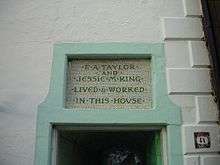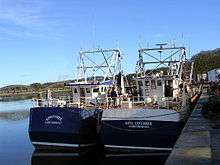Kirkcudbright
Kirkcudbright
| |
|---|---|
|
Kirkcudbright | |
 Kirkcudbright | |
| Kirkcudbright shown within Dumfries and Galloway | |
| Population | 3,352 (2011) |
| OS grid reference | NX685505 |
| Council area | |
| Lieutenancy area | |
| Country | Scotland |
| Sovereign state | United Kingdom |
| Post town | KIRKCUDBRIGHT |
| Postcode district | DG6 |
| Dialling code | 01557 |
| Police | Scottish |
| Fire | Scottish |
| Ambulance | Scottish |
| EU Parliament | Scotland |
| UK Parliament | |
| Scottish Parliament | |
Kirkcudbright, (/kərˈkuːbriː/ kirr-KOO-bree; Scottish Gaelic: Cille Chuithbeirt) is a town and parish in Kirkcudbrightshire, of which it is traditionally the county town, within Dumfries and Galloway, Scotland.
The town lies southwest of Castle Douglas and Dalbeattie at the mouth of the River Dee, some 4 miles (6 kilometres) from the Irish Sea.
History
An early rendition of the name of the town was Kilcudbrit;[2] this derives from the Gaelic Cille Chuithbeirt meaning "chapel of Cuthbert", the saint whose mortal remains were kept at the town between their exhumation at Lindisfarne and reinterment at Chester-le-Street.[3]
Spottiswood, in his account of religious houses in Scotland, mentions that the Franciscans or Grey Friars had been established at Kirkcudbright from the 12th century.[4] No traces of the Greyfriars or Franciscan dwellings remain in the parish of Kirkcudbright.
In 1453 Kirkcudbright became a royal burgh,[5] and about a century later, the magistrates of the town obtained permission from Queen Mary to use part of the convent and nunnery as a parish church. From around 1570, Sir Thomas MacLellan of Bombie, the chief magistrate, received a charter for the site, its grounds and gardens. MacLellan dismantled the church in order to obtain material for his new castle, a very fine house, which was built on the site.[6]
After defeat at the Battle of Towton, Henry VI of England crossed the Solway Firth in August 1461 to land at Kirkcudbright in support of Queen Margaret at Linlithgow. The town also for some time withstood a siege in 1547 from the English commander Sir Thomas Carleton but after the surrounding countryside had been overrun was compelled to surrender.[7]
Kirkcudbright Tolbooth was built between 1625 and 1629 and served not only as the tolbooth, but also the council offices, the burg and sheriff courts, the criminal prison and the debtors' prison. One of the most famous prisoners was John Paul Jones, hero of the American navy, who was born in nearby Kirkbean.[8][9]
The Kirkcudbright Railway opened in 1864 but the railway line and station closed in 1965.[10]
The war memorial dates from 1922 and is by George Henry Paulin.[11]
Kirkcudbright Training Area
Like many other remote areas during World War II, a 4,700-acre (19 km2) area to the southeast of the town and extending to the coast of the Solway Firth, was acquired by the Army in 1942, as a training area for the D Day invasion.[12][13] The area remains in active use for live-firing exercises to this day. Part of the training area is the Dundrennan Range, a weapons development and testing range. The use of this range for the testing of depleted uranium shells has been controversial.[14][15] The range also contains one of the two surviving A39 Tortoise heavy assault tanks from the six prototypes originally produced. The 32-pdr gun has been removed and the tank is used for target practice. Due to the range's designation as a Site of Special Scientific Interest, removal of the tank to a museum is unlikely.
Museums
Broughton House is an 18th-century town house standing on the High Street. It was the home of Scots impressionist artist Edward Atkinson Hornel between 1901 and his death in 1933. The National Trust for Scotland maintain the house and its contents as a museum of Hornel's life and work.
The Stewartry Museum was founded in 1879 and was at first based in the Town Hall until it became too small to house the collections.[16][17] The collection moved to a purpose built site and contains the local and natural history of the Stewartry of Kirkcudbright. Britain's earliest surviving sporting trophy, the Siller Gun,[18] is part of the collection, as are paintings by many local artists.
The Tolbooth building is now used as an Arts Centre.[19][20][21]
Notable people

Kirkcudbright has had a long association with the Glasgow art movement, which started when several artists, including the Glasgow Boys and the famed Scottish Colourists, such as Samuel Peploe and Francis Cadell, based themselves in the area over a 30-year period from 1880 to 1910, establishing the Kirkcudbright Artists' Colony.
Many of them moved to the town from Glasgow, including Edward Hornel, George Henry and Jessie M. King. Later another small group of Glasgow trained artists built their studios across the river at The Stell, including John Charles Lamont and Robert Sivell. Landscape painter Charles Oppenheimer moved to Kirkcudbright in 1908, and is given credit along with artist Dorothy Nesbitt for protecting the Harbor Cottage (art) Gallery from demolition in 1956. The presence of these and other accredited artists led to Kirkcudbright becoming known as "the artists' town", although town residents see the town as a "fishing town": as the town has a harbour, this soubriquet may have originated more from tourist-board publicity[22] rather than local usage.
Landscape and figure painter William Hanna Clarke lived in Kirkcudbright and many of his works featured Kirkcudbright. He is buried in the town's churchyard and his tombstone was carved by friend, Glasgow sculptor, Alexander Proudfoot.[23]
Kirkcudbright has been home to some professional footballers, most notably Bob McDougall, George Cloy and David Mathieson.[24][25][26]
David MacMyn, Scottish rugby international, was from Kirkcudbright as was Ellis Cooper-Frater's family.[27]
Composer Cecil Coles was born in Kirkcudbright.[28]
Sport
Kirkcudbright is represented in the South of Scotland Football League by St Cuthbert Wanderers FC.[29] The club's best-known former players are Bob McDougall, Billy Halliday and David Mathieson.[24]
Cinema and literature


The whodunit Five Red Herrings by Dorothy L. Sayers involves the artistic community of Kirkcudbright.[30] In 1975, the book was made into a BBC TV film shot in the town, with Ian Carmichael playing the lead role of Lord Peter Wimsey.[31]
The town also provided locations for the cult 1973 horror film The Wicker Man.[32] Several parts of the town can be easily recognised in the film.
Robert Urquhart starred in a 1980 BBC adaptation of Ibsen's An Enemy of the People, shot on location in Kirkcudbright.
Music
The lyricist and poet Marriott Edgar who wrote, amongst other things, Albert and the Lion for Stanley Holloway was born in Kirkcudbright in 1880.
The composer Cecil Coles, who studied under Holst and was killed by sniper fire towards the end of World War I was born in Kirkcudbright in 1888.
The band Betrayal, which comprised Kirkcudbright musician Stephen Milligan (lead guitar), Mervin Macklin (rhythm guitar) and Stephen McClelland (keyboards), as well as Andrew Black (bass), Blue (vocals) and Marty (drums) released an album "Rattlesnake Waltz" on Liverpool's Probe Plus records in 1987. As reviewed in Q magazine at the time as "This seven-piece outfit from Galloway make their album debut with a strange brew containing a healthy dash of speed metal and a fistful of disparate elements taken from early Genesis, The lovin' Spoonful, Led Zeppelin, and The Skids. On paper this might seem unworkable but in reality it adds up to a highly individual sound, with tracks like Made, Dead Man's Hand and No Big Thing - where Sue Dring's soaring vocals form an attractive contrast to Steve McClelland's manic synthesizer-providing the high spots. The only obvious drawback to this formula is that by utilising such an unusual variety of influences the band may be limiting their appeal to lovers of the eccentric . . . ."
References
- ↑ Ainmean-Àite na h-Alba (2011) 'Ainmean-Àite na h-Alba - Gaelic Place-Names of Scotland - Database', Ainmean-Aite.org. Uniform Resource Locator: http://www.gaelicplacenames.org/databasedetails.php?id=851
- ↑ Learmonth, W (2012) Kirkcudbrightshire and Wigtownshire, Cambridgeshire: Cambridge University Press
- ↑ Eyre, C (1849) The History of St. Cuthbert: Or an Account of His Life, Decease, and Miracles; of the Wanderings with his Body at Intervals During CXXIV. Years; of the State of his Body from his Decease Until A.D. 1542; and of the Various Monuments Erected to His Memory., City of Westminster: James Burns
- ↑ Spottiswood, J (1655) The history of the Church of Scotland, beginning in the year of our Lord 203 and continued to the end of the reign of King James the VI of ever blessed memory : wherein are described the progress of Christianity, the persecutions and interruptions of it, the foundation of churches, the erecting of bishopricks, the building and endowing monasteries, and other religious places, the succession of bishops in their sees, the reformation of religion, and the frequent disturbances of that nation by wars, conspiracies, tumults, schisms : together with great variety of other matters, both ecclesiasticall and politicall, City of London: J. Flesher for R. Royston
- ↑ Bell, J (2015) 'Old Kirkcudbright - History of an Ancient Parish & Burgh.', Kirkcudbright Community Website.
- ↑ Coventry, M (2006) The Castles of Scotland, City of Edinburgh: Birlinn Limited
- ↑ [Nicolson, J and Burn, R (1777) The History and Antiquities of the counties of Westmorland and Cumberland. In Two Volumes. Vol 1. City of Westminster: W. Strahan; and T. Cadell (Google Books (2009) Internet Archive: https://archive.org/stream/historyandantiq00burngoog#page/n60/mode/2up.asp Account of Sir Thomas Carleton])
- ↑ Slaving and a Murder Trial. Retrieved on 14 November 2012.
- ↑ 1770 Extract of Warrant for the arrest of John Paul (Jones). Scan.org.uk. Retrieved on 14 November 2012.
- ↑ Canmore (2006) 'Kirkcudbright, St Mary Street, Railway Station | Canmore', Royal Commission on the Ancient and Historical Monuments of Scotland. Uniform Resource Locator: http://canmore.org.uk/site/69353/kirkcudbright-st-mary-street-railway-station
- ↑ Edwards, M (2006) ‘Roll of Honour - Kirkcudbrightshire - Kircudbright’, Roll-of-Honour.com. Uniform Resource Locator: http://www.roll-of-honour.com/Kirkcudbrightshire/Kirkcudbright.html
- ↑ "Kirkcudbright Training Area". Ministry of Defence.
- ↑ "Kirkcudbright Training Area".
- ↑ "Call to stop uranium shell tests". BBC News. 7 February 2001.
- ↑ "Weapon test move comes under fire". BBC News. 11 March 2008.
- ↑ Museums Galleries Scotland (2015) 'The Stewartry Museum', Museums Galleries Scotland. Uniform Resource Locator: http://www.museumsgalleriesscotland.org.uk/member/the-stewartry-museum
- ↑ Dumfries and Galloway Council (2105) 'Dumfries and Galloway Council : The Stewartry Museum, Kirkcudbright', Dumfries and Galloway Council. Uniform Resource Locator: http://www.dumgal.gov.uk/index.aspx?articleid=3638
- ↑ Bell, J (2015) 'Kirkcudbright's Siller (Silver) Gun', Kirkcudbright Community Website. Uniform Resource Locator: Siller Gun. Old-kirkcudbright.net. Retrieved on 22 June 2011.
- ↑ Tolbooth Arts Centre. Kirkcudbright.co.uk. Retrieved on 22 June 2011.
- ↑ Dumfries and Galloway Council (2015) 'Dumfries and Galloway Council : Tolbooth Art Centre, Kirkcudbright', Dumfries and Galloway Council. Uniform Resource Locator: http://www.dumgal.gov.uk/index.aspx?articleid=3639
- ↑ VisitScotland (2015) 'Tolbooth Art Centre - Kirkcudbright - VisitScotland', VisitScotland.com. Uniform Resource Locator: http://www.visitscotland.com/info/see-do/tolbooth-art-centre-p249601
- ↑ Artists' Town official website. Kirkcudbright. Retrieved on 22 June 2011.
- ↑
- 1 2 McCartney, I (2008) Queen of the South: The History 1919-2008, Staffordshire: The Breedon Books Publishing Company Limited
- ↑ McLean, K (2009) 'QosFC: Legends - George Cloy', Queen of the South Football Club Limited. Uniform Resource Locator: http://qosfc.com/content-legendsView.aspx?playerid=1050
- ↑ McLean, K (2009) 'QosFC: Legends - Tommy Bryce', Queen of the South Football Club Limited. Uniform Resource Locator: http://qosfc.com/content-legendsView.aspx?playerid=1045
- ↑ HG (1978) 'Obituary', British Medical Journal, 1 (6119, April), 1058 to 1060
- ↑ Commonwealth War Graves Commission (1918) 'Comprehensive Report', Grave Registration Reports. Uniform Resource Locator: http://www.cwgc.org/find-war-dead/casualty/71046/COLES,%20CECIL%20FREDERICK%20G
- ↑ St Cuthbert Wanderers FC (2014) 'St Cuthbert Wanderers FC', Custom Software Systems. Uniform Resource Locator: http://www.stcuthbertwanderers.co.uk/
- ↑ Five Red Herrings
- ↑ IMDb.com, Incorporation (1990) 'Five Red Herrings (TV Mini-Series 1975) - IMDb', Internet Movie Database. Uniform Resource Locator: http://www.imdb.com/title/tt0072502/
- ↑ "Where was 'The Wicker Man' filmed?". British Film Locations. Retrieved 5 June 2017.
External links
-
 Media related to Kirkcudbright at Wikimedia Commons
Media related to Kirkcudbright at Wikimedia Commons - Visit Kirkcudbright Website
- Kirkcudbright Community Website